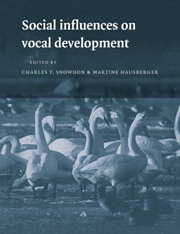Book contents
- Frontmatter
- Contents
- List of contributor
- 1 Introduction
- 2 Social interaction and sensitive phases for song learning: A critical review
- 3 Social interaction and vocal development in birds
- 4 Building a social agenda for the study of bird song
- 5 Field observations, experimental design, and the time and place of learning bird songs
- 6 Vocal learning in wild and domesticated zebra finches: Signature cues for kin recognition or epiphenomena?
- 7 What birds with complex social relationships can tell us about vocal learning: Vocal sharing in avian groups
- 8 Social influences on song acquisition and sharing in the European starling (Sturnus vulgaris)
- 9 Social influences on the acquisition of human-based codes in parrots and nonhuman primates
- 10 Vocal learning in captive bottlenose dolphins: A comparison with humans and nonhuman animals
- 11 Vocal learning in cetaceans
- 12 Social influences on vocal development in New World primates
- 13 Some general features of vocal development in nonhuman primates
- 14 Social influences on vocal learning in human and nonhuman primates
- 15 The resilience of language in humans
- 16 Reciprocal interactions and the development of communication and language between parents and children
- 17 Crafting activities: Building social organization through language in girls' and boys' groups
- Index
2 - Social interaction and sensitive phases for song learning: A critical review
Published online by Cambridge University Press: 04 August 2010
- Frontmatter
- Contents
- List of contributor
- 1 Introduction
- 2 Social interaction and sensitive phases for song learning: A critical review
- 3 Social interaction and vocal development in birds
- 4 Building a social agenda for the study of bird song
- 5 Field observations, experimental design, and the time and place of learning bird songs
- 6 Vocal learning in wild and domesticated zebra finches: Signature cues for kin recognition or epiphenomena?
- 7 What birds with complex social relationships can tell us about vocal learning: Vocal sharing in avian groups
- 8 Social influences on song acquisition and sharing in the European starling (Sturnus vulgaris)
- 9 Social influences on the acquisition of human-based codes in parrots and nonhuman primates
- 10 Vocal learning in captive bottlenose dolphins: A comparison with humans and nonhuman animals
- 11 Vocal learning in cetaceans
- 12 Social influences on vocal development in New World primates
- 13 Some general features of vocal development in nonhuman primates
- 14 Social influences on vocal learning in human and nonhuman primates
- 15 The resilience of language in humans
- 16 Reciprocal interactions and the development of communication and language between parents and children
- 17 Crafting activities: Building social organization through language in girls' and boys' groups
- Index
Summary
INTRODUCTION
A major focus in the study of bird song over the past three decades has been on the involvement of learning during development. At a basic level, two models of learning mechanisms have been proposed: instructive and selective (Jerne 1967; Changeux et al. 1984). In an instructive model, environmental stimulation adds information not already present in the behavioral repertoire. When a young bird memorizes a novel song, it is instructed. In contrast, in a selective model, learning consists of the selection of behavior(s) from a pre-existing repertoire as a function of experience. At the time of stimulation, the animal already possesses the potential or ability to perform the behavior. Therefore, the test to distinguish between the two models is to present a novel stimulus and to record whether it is learned.
Research on song learning has been guided largely by an instructive model of learning, embodied in the sensorimotor model first proposed in Konishi's (1965) study of song development in the white-crowned sparrow (Zonotrichia leucophrys). The sensorimotor model includes two stages: a sensory (instructive) phase in which songs are memorized, and a sensorimotor phase in which the bird compares its own song, via auditory feedback, to the memory trace acquired earlier.
One consequence of song learning is the formation of geographic “dialects” in which males at one location sing similar songs that differ from those of the same species at other locations. If vocal plasticity in birds is mediated solely by an instructive mechanism, then song matching dialects arise when males breed in the same area where they acquired their song(s).
- Type
- Chapter
- Information
- Social Influences on Vocal Development , pp. 7 - 22Publisher: Cambridge University PressPrint publication year: 1997
- 31
- Cited by

